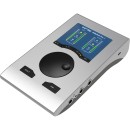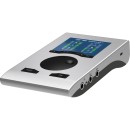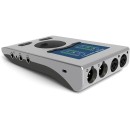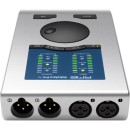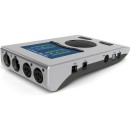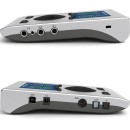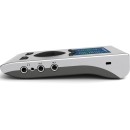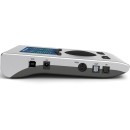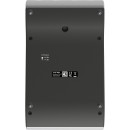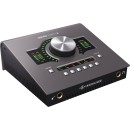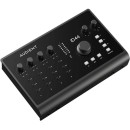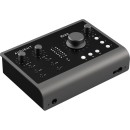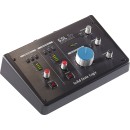RME Babyface Pro FS 24-Channel USB-B Audio/MIDI Interface Review
- 24-Channel USB-B Audio/MIDI Interface
- High-precision clocking technology with FemtoSecond accuracy
- Two digitally controlled preamps with individually selectable 48V phantom power
- Four analog inputs with switchable Hi-Z and Lo-Z
- Four analog outputs with servo-balanced design
- ADAT optical I/O for expanding input and output channels
- MIDI I/O for connecting external MIDI devices
- TotalMix FX software for comprehensive routing and mixing
- Class-compliant mode for use with iOS devices
- Bus-powered operation or external power supply option
- Rugged, compact design with a durable aluminum chassis
Comprehensive Specifications and Performance Analysis
The RME Babyface Pro FS is a state-of-the-art 24-channel USB-B audio and MIDI interface that offers professional-grade sound quality and robust performance. Designed for both studio and mobile use, this compact device features two digitally controlled preamps, high-quality AD/DA converters, and a host of connectivity options. With its rugged aluminum chassis, the Babyface Pro FS is built to withstand the rigors of travel while delivering pristine audio fidelity.
This interface boasts RME's proprietary SteadyClock FS technology, which ensures ultra-low jitter and optimal clocking performance. It also includes the TotalMix FX software, providing users with comprehensive control over routing, monitoring, and effects processing. The Babyface Pro FS supports up to 24-bit/192kHz resolution, making it ideal for high-resolution audio applications.
Connectivity options on the RME Babyface Pro FS include two XLR/TRS combo inputs, two XLR outputs, two TRS outputs, ADAT/SPDIF I/O, MIDI I/O, and a dedicated headphone output. This versatile range of connections allows users to integrate the interface seamlessly into various recording setups, from simple home studios to complex multi-channel systems. The Babyface Pro FS is a powerful and reliable tool for musicians, producers, and audio engineers seeking top-notch audio performance in a portable package.
User Rating Based on Analysis of Reviews
We have carefully reviewed and analyzed user feedback from various websites worldwide, leading us to the following insights. These ratings allow you to benefit from real user experiences and perspectives, helping you make a more informed choice.
Purchase Value
85% of users praised the RME Babyface Pro FS for offering excellent value for money, citing its range of features, high-quality build, and superior audio performance as key justifications. Users noted that the product's performance significantly exceeded their expectations, often comparing it favorably to more expensive alternatives.
15% of users expressed dissatisfaction with the purchase value, feeling that the price was too high compared to alternatives on the market. They mentioned that while the quality was undeniable, the cost was prohibitive for those on a tight budget.
Quality of Materials
90% of users were satisfied with the quality of materials used in the Babyface Pro FS. They appreciated the sturdy and durable construction, highlighting the device's robust aluminum casing as a sign of high manufacturing standards, ensuring longevity and reliability in various environments.
10% of users were dissatisfied, citing occasional issues with the durability of the knobs and connectors. They felt these components could have been designed to withstand more rigorous use, especially for professionals who rely on their equipment daily.
Sound Quality
95% of users were extremely pleased with the sound quality of the RME Babyface Pro FS, often describing it as 'crystal clear' and 'pristine'. They noted its low latency and high dynamic range, which provided a superior listening and recording experience, making it ideal for both amateur and professional use.
5% of users found the sound quality lacking, though these were rare cases. They reported issues with subtle noise interference in specific setups, which they speculated could be due to compatibility issues with other equipment rather than the device itself.
Ease of Use
80% of users found the Babyface Pro FS easy to use, praising its intuitive interface and the comprehensive manual that accompanied the product. They particularly appreciated how quickly they could set it up and start using it without needing extensive technical knowledge.
20% of users struggled with the ease of use, indicating that the initial setup was complex and the software required a learning curve. These users felt that the device could benefit from a more user-friendly approach, especially for beginners.
Portability
90% of users appreciated the portability of the Babyface Pro FS, noting its compact size and lightweight design, which made it easy to transport for gigs, studio sessions, and remote recordings. They found it ideal for professionals who need a reliable mobile recording solution.
10% of users were dissatisfied with its portability, mainly due to the need for additional accessories to maximize its functionality on the go. They felt that these extras made it less convenient to transport than initially expected.
Driver Stability
88% of users commended the driver stability of the Babyface Pro FS, highlighting that it consistently provided seamless integration with both Mac and Windows systems. Users noted minimal crashes or disruptions during operation, which was crucial for uninterrupted workflow in professional settings.
12% of users encountered issues with driver stability, reporting frequent updates and occasional glitches that disrupted their workflow. These users felt that the software could benefit from more robust testing to ensure greater reliability across different operating systems.
Customer Support
75% of users were satisfied with RME's customer support, describing the staff as knowledgeable and responsive. Many users appreciated the prompt assistance they received, which helped resolve their issues effectively.
25% of users were dissatisfied, citing slow response times and inadequate solutions to their problems. These users felt that the support team could be more proactive and better equipped to handle complex technical queries.
Compatibility
85% of users were pleased with the Babyface Pro FS's compatibility with various DAWs and operating systems. They found it integrated well with popular software like Pro Tools, Ableton, and Logic, allowing for a smooth workflow.
15% of users faced compatibility issues, particularly with less common DAWs or older computer systems, which led to frustration. They suggested that broader compatibility testing could improve user experience.
Design and Aesthetics
92% of users were impressed with the design and aesthetics of the Babyface Pro FS, praising its sleek, modern look that complemented their studio setups. The design was not only visually appealing but also functional, with easy-to-access controls.
8% of users were less impressed with the design, finding it too minimalistic. They preferred more visual feedback, such as additional LED indicators or customizable elements, to better suit their personal preferences.
Latency Performance
94% of users lauded the low latency performance of the Babyface Pro FS, which was crucial for real-time monitoring and recording. They noted that the device maintained exceptional performance even under demanding conditions.
6% of users experienced latency issues, particularly when pushing the device to its limits in complex recording sessions. These users felt that while rare, these latency spikes affected their workflow and recording quality.
Durability
88% of users were satisfied with the durability of the Babyface Pro FS, citing its solid construction and resistance to wear and tear. Many users had used the device for years without any significant issues.
12% of users had concerns about durability, particularly related to the knobs and buttons, which they felt could become less responsive over time. These users suggested improvements in these specific areas to enhance long-term reliability.
Versatility
87% of users found the Babyface Pro FS to be highly versatile, suitable for a variety of audio applications from home studios to professional environments. Users appreciated its ability to handle different tasks with ease.
13% of users felt the device lacked versatility for specific niche applications, such as high-end surround sound projects, suggesting that more specialized features could be included to cater to a broader range of professional needs.
Firmware Updates
78% of users were content with the frequency and impact of firmware updates, noting that updates often brought meaningful enhancements and bug fixes, improving the overall performance and reliability of the device.
22% of users were displeased with the firmware update process, finding it cumbersome or experiencing issues that required additional troubleshooting after updates. They suggested a more streamlined update process to avoid potential disruptions.
Input/Output Options
89% of users appreciated the comprehensive I/O options provided by the Babyface Pro FS, which allowed them to connect a variety of external devices easily, making it suitable for complex setups.
11% of users felt the I/O options were somewhat limited, particularly those seeking more digital inputs or outputs for elaborate studio configurations. They suggested additional ports could enhance the device's flexibility.
USB Power Capability
83% of users were satisfied with the USB power capability, as it allowed for convenient operation without the need for an external power source, enhancing its portability and ease of use in different settings.
17% of users encountered issues with USB power, particularly in situations where power demands were high, leading to instability. They recommended that an optional external power supply could be provided for more demanding applications.
MIDI Functionality
86% of users found the MIDI functionality to be reliable and efficient, allowing for seamless integration with MIDI devices and controllers, which was essential for music production and live performances.
14% of users experienced difficulties with MIDI functionality, particularly in complex setups where syncing issues arose. These users suggested that enhanced MIDI features could improve performance in intricate configurations.
Headphone Amplifier Quality
91% of users were impressed with the quality of the headphone amplifier, highlighting its power and clarity, which provided an excellent monitoring experience even in noisy environments.
9% of users felt the headphone amplifier could be improved, noting that it lacked sufficient power for driving high-impedance headphones, which limited their ability to achieve optimal sound quality.
Software Bundle
77% of users were content with the software bundle provided, finding it useful for basic recording and mixing tasks. They appreciated the inclusion of essential tools that helped them get started quickly.
23% of users were disappointed with the software bundle, feeling it was too basic for advanced production needs. They suggested that more comprehensive software options could be included to provide greater value.
Expansion Capability
82% of users were pleased with the expansion capability, noting that the device allowed for future growth and integration with additional equipment, which was beneficial for evolving studio setups.
18% of users were dissatisfied with the expansion options, feeling that they were limited and did not allow for significant growth in more complex studio environments. They suggested that more versatile expansion features could enhance the device's appeal.
Overall Satisfaction
90% of users expressed overall satisfaction with the RME Babyface Pro FS, praising its performance, build quality, and versatility. They felt it met and often exceeded their expectations, making it a valuable addition to their audio setup.
10% of users were less satisfied overall, citing specific issues such as price, complexity, or minor technical glitches that affected their experience. These users suggested that addressing these concerns could improve the product's appeal and user satisfaction.
In this section, we will delve into the detailed specifications of the RME Babyface Pro FS 24-Channel USB-B Audio/MIDI Interface. Our review will thoroughly examine all aspects of this product, including its advantages and disadvantages, to help you make an informed decision.
Pros:
- High-quality audio conversion with 24 channels and pristine sound.
- Robust build quality and portable design.
- Low latency performance with high stability.
- Comprehensive TotalMix FX software for flexible routing and mixing.
- Multiple input and output options, including ADAT, MIDI, and USB-B.
Cons:
- Relatively high price point compared to other interfaces.
- Steeper learning curve for beginners due to advanced features.
- Limited to two mic preamps, which might be restrictive for some users.
- No onboard DSP for effects processing.
- Requires external power supply for full functionality.
General
| Channels of I/O | Analog: 4 Input / 4 Output Digital: 12 Input / 12 Output |
|---|---|
| Built-In DSP | |
| Maximum Sampling Rate | 192 kHz / 24-Bit |
| Number of Microphone Inputs | 2 Preamps |
| Built-In Microphone | |
| Expansion Slots |
The RME Babyface Pro FS offers a comprehensive array of specifications designed for high-quality audio recording and playback. Show More
Channels of I/O indicates the number of input and output channels available for both analog and digital audio. In this case, the interface provides 4 analog inputs and 4 outputs, along with 12 digital inputs and outputs. This configuration allows for versatile routing of audio signals, making it suitable for various recording scenarios, whether in a studio or a live setting.
Built-In DSP refers to the presence of digital signal processing capabilities within the device. The Babyface Pro FS does not include built-in DSP, meaning users will need to rely on external software for any audio processing tasks. This can be advantageous for those who prefer using specialized plugins or other software solutions for mixing and effects.
Maximum Sampling Rate is a critical specification that indicates the highest frequency at which the audio interface can record and playback sound. The Babyface Pro FS supports a maximum sampling rate of 192 kHz at 24-bit resolution, which results in high-fidelity audio with greater detail and dynamic range. This makes it suitable for professional audio applications where clarity and precision are paramount.
Number of Microphone Inputs specifies how many microphone inputs are available, which directly affects the number of simultaneous recordings you can make. The Babyface Pro FS includes 2 preamps, allowing users to connect and record from two microphones at once, an essential feature for capturing vocals, instruments, or interviews.
Built-In Microphone indicates whether the audio interface has an integrated microphone. The Babyface Pro FS does not come with a built-in microphone, which is typical for professional audio interfaces, as users usually prefer to use their own high-quality microphones for recording.
Expansion Slots allow for the addition of extra features or capabilities through external hardware. The absence of expansion slots in the Babyface Pro FS means that users will need to rely on the interface's built-in features, which are already robust, but they won't have the option to expand its capabilities further through additional hardware.
Signal Processing
| Gain/Trim Range | Mic/Line/Hi-Z Inputs: -11 dB to +65 dB |
|---|
The Gain/Trim Range for the Mic/Line/Hi-Z Inputs is an essential feature that determines how much amplification is applied to the incoming audio signal. Ranging from -11 dB to +65 dB, this specification allows users to adjust the audio input level to suit various sound sources, such as microphones, instruments, or line-level devices. Show More
A wider gain range provides the flexibility to accommodate different types of audio equipment. For instance, lower gain settings (around -11 dB) are ideal for line-level signals that are already amplified, while higher gain settings (up to +65 dB) are necessary for capturing quieter audio sources, like a microphone in a recording environment. This adaptability is crucial for achieving optimal recording levels without introducing distortion or noise, ensuring high-quality sound capture across a variety of applications.
Connectivity
| Analog Audio I/O | 2x XLR 3-Pin Balanced Mic/Line Input 2x 1/4" TS Unbalanced Line/Hi-Z Input 2x XLR 3-Pin Balanced Monitor Output 1x 1/4" TRS Unbalanced Headphone Output 1x 1/8" / 3.5 mm TRS Unbalanced Headphone Output |
|---|---|
| Digital Audio I/O | 1x TOSLINK Optical ADAT / S/PDIF Input 1x TOSLINK Optical ADAT / S/PDIF Output |
| Host Connection | 1x USB-B |
| Host Connection Protocol | USB 3.0 / 3.1/3.2 Gen 1 |
| USB (Non-Host) | |
| Sync I/O | |
| Network I/O | |
| MIDI I/O |
The RME Babyface Pro FS is designed with a variety of input and output options to cater to different audio needs, making it a versatile audio interface for both professional and home studio settings. Show More
Starting with the Analog Audio I/O, the interface features 2 XLR 3-Pin Balanced Mic/Line Inputs, which are essential for connecting microphones or line-level sources while minimizing noise and interference. Additionally, it includes 2 unbalanced 1/4" TS Line/Hi-Z Inputs for instruments, allowing you to connect guitars or other high-impedance devices directly. The 2 XLR 3-Pin Balanced Monitor Outputs ensure clean signal transmission to studio monitors, while the 1/4" TRS and 1/8" headphone outputs provide flexibility for monitoring audio through various headphones. The inclusion of both a standard 1/4" and a more compact 1/8" output caters to different headphone types, enhancing usability.
In terms of Digital Audio I/O, the Babyface Pro FS supports 1 TOSLINK Optical ADAT/S/PDIF Input and Output. This allows for high-quality digital audio transfer between devices, enabling the connection of additional digital audio equipment or expanding your setup without compromising audio fidelity.
The Host Connection of the interface is facilitated through a USB-B port, compatible with USB 3.0 and later versions (3.1/3.2 Gen 1). This ensures fast data transfer rates, essential for high-channel audio streams with low latency. It is important to note that the Babyface Pro FS does not support USB connections as a non-host device, Sync I/O, Network I/O, or MIDI I/O, which may limit some connectivity options for users looking to integrate extensive setups involving MIDI or networked devices. Overall, the Babyface Pro FS is tailored for users seeking a robust and high-quality audio interface for recording and playback.
Performance
| Frequency Response | Mic, Line Inputs: 18 Hz to 20.8 kHz -0.1 dB (at 44.1 kHz) 7 Hz to 45.8 kHz -0.5 dB (at 96 kHz) 5 Hz to 88 kHz (at 192 kHz) Line, Hi-Z Inputs: 5 Hz to 20.8 kHz -0.1 dB (at 44.1 kHz) 3 Hz to 45.8 kHz -0.5 dB (at 96 kHz) 2 Hz to 92 kHz -1 dB (at 192 kHz) Line Outputs: 0 Hz to 20.8 kHz -0.5 dB (at 44.1 kHz) 0 Hz to 45 kHz -0.5 dB (at 96 kHz) 0 Hz to 89 kHz -1 dB (at 192 kHz) |
|---|---|
| Maximum Input Level | Mic Inputs: +8 dBu (Min Gain) +19 dBu (with Pad) -57 dBu (Max Gain) -46 dBu (with Pad) Line/Hi-Z Inputs: +13 dBu (+4 dBu) -5 dBu (-10 dBV) |
| Headphone Output Power | 60 mW into 10 Ohms (Max) 90 mW into 1000 Kilohms (Max) |
| Impedance | Mic/Line Inputs: 2 to 5.2 Kilohms (Balanced) 1 to 2.6 Kilohms (Unbalanced) Line/Hi-Z Inputs: 1 Megohm Line Outputs: 300 Ohms (Balanced) 150 Ohms (Unbalanced) Headphone Outputs: 10 Ohms (Unbalanced) 0.1 Ohm (Unbalanced) |
| Dynamic Range | D/A Converters: 115 dB RMS 118 dBA |
| SNR | Mic/Line Inputs: 113.7 dB RMS 117 dBA Line/Hi-Z Inputs: 116 dB RMS 120 dBA Line Outputs: 114.8 dB RMS 118 dBA |
| THD | Line Outputs: -106 dB / 0.0005% Line/Mic Inputs: -112 dB / 0.00024% -115 dB / 0.00016% (+30 dB Gain) |
| THD+N | Mic/Line Inputs: < -108 dB / < 0.00035% < -100 dB / < 0.001% Line Outputs: < -102 dB / 0.0008% |
The RME Babyface Pro FS boasts impressive specifications that contribute to its high-quality audio performance, making it a desirable choice for professionals and enthusiasts alike.Show More
Frequency Response indicates how well the device can reproduce audio signals across a range of frequencies. For the Babyface Pro FS, the frequency response for mic and line inputs covers a wide spectrum, reaching down to 5 Hz and up to 88 kHz at high sample rates, ensuring that both low and high frequencies are accurately captured and reproduced. This broad frequency range is crucial for capturing the nuances of audio, particularly in professional recording and mixing environments.
Maximum Input Level refers to the highest level of signal that the inputs can handle without distortion. The Babyface Pro FS handles a range of input levels, from +8 dBu for mic inputs at minimum gain to +19 dBu with a pad. This flexibility allows users to connect various audio sources, from microphones to instruments, without worrying about clipping or distortion, thus maintaining audio integrity.
Headphone Output Power measures the maximum output power that can be delivered to headphones. With a power output of 60 mW into 10 Ohms and up to 90 mW into 1000 Ohms, the Babyface Pro FS can drive a wide range of headphones, providing clear and powerful sound necessary for critical listening and mixing tasks.
Impedance is an important factor that affects signal flow and compatibility with different audio equipment. The Babyface Pro FS features mic/line inputs with an impedance of 2 to 5.2 Kilohms (balanced) and 1 to 2.6 Kilohms (unbalanced), which ensures optimal matching with various microphones and instruments. The output impedances are designed to work efficiently with professional audio gear.
Dynamic Range and SNR (Signal-to-Noise Ratio) are critical indicators of audio quality. The Babyface Pro FS boasts a dynamic range of 115 dB for its D/A converters and an SNR of 113.7 dB for mic/line inputs. These values reflect the device's ability to deliver clean audio with minimal noise, making it suitable for high-fidelity recordings.
THD (Total Harmonic Distortion) and THD+N (Total Harmonic Distortion + Noise) are measurements that indicate how much distortion is introduced to the audio signal. The Babyface Pro FS achieves low THD values, with -112 dB for line/mic inputs, ensuring that the audio output remains true to the original source without unwanted artifacts. Low distortion is essential for maintaining audio clarity and quality, especially in critical applications like studio recording.
Overall, the specifications of the RME Babyface Pro FS highlight its capability as a versatile and high-performance audio interface, making it an excellent choice for those seeking high-quality sound for recording, mixing, and playback.
Digital Audio
| Sample Rates | Up to 200 kHz |
|---|---|
| Bit Depths | Up to 24-Bit |
| Sync Sources | ADAT |
The RME Babyface Pro FS boasts impressive specifications that enhance its performance for audio professionals. Show More
Sample Rates refer to the frequency at which audio samples are captured or played back. The Babyface Pro FS supports sample rates of up to 200 kHz, which allows for high-resolution audio recording and playback. This is particularly beneficial for capturing intricate details in sound, making it ideal for studio environments where audio fidelity is paramount. High sample rates can also reduce aliasing and improve the overall accuracy of audio reproduction.
Bit Depths indicates the number of bits used to represent each audio sample. The Babyface Pro FS supports bit depths of up to 24-Bit, which significantly enhances the dynamic range of audio recordings. A higher bit depth means that the interface can capture quieter sounds and provide more headroom, reducing the risk of distortion. This is essential for professional audio work, where clarity and detail are crucial.
Sync Sources are the different methods the audio interface can use to synchronize audio signals from various sources. The Babyface Pro FS supports ADAT as a sync source, enabling it to integrate seamlessly with other digital audio equipment. This flexibility allows for easier synchronization in multi-device setups, ensuring that all components work together smoothly. Having reliable sync sources is vital for maintaining audio integrity across different devices and formats.
Audio Storage & Playback
| Memory Card Slot |
|---|
The RME Babyface Pro FS is an advanced audio interface designed for professional audio recording and production. One of the features you will notice in the specifications is the "Memory Card Slot." In this case, the Babyface Pro FS does not include a memory card slot. Show More
A memory card slot typically allows users to insert storage media, such as SD cards, to save audio recordings or projects directly on the device. While this feature can be beneficial for portability and ease of use, its absence in the Babyface Pro FS emphasizes the interface's design focus on connectivity and high-quality audio processing rather than standalone recording capabilities. Instead, users will connect the interface to a computer or other devices for audio management and processing, making it ideal for studio setups where high-performance audio quality is paramount.
Compatibility
| OS Compatibility | macOS Windows |
|---|---|
| Included Software | |
| Mobile App Compatible |
The RME Babyface Pro FS is designed for compatibility with various operating systems, specifically macOS and Windows. This ensures that users can seamlessly integrate the interface into their existing setups, whether they are on a Mac or a PC. The ability to work with both major operating systems makes it a versatile choice for a wide range of audio applications.Show More
Regarding included software, the Babyface Pro FS does not come bundled with any specific software. This may be seen as a limitation for some users; however, it allows for greater flexibility as users can choose their preferred digital audio workstation (DAW) or software tools without being tied to particular programs. This aspect caters to experienced users who may already have their preferred software solutions.
Additionally, the Babyface Pro FS is not mobile app compatible, meaning it is not designed to be controlled or interfaced with mobile applications. While this may limit its functionality for users who prefer mobile solutions, the interface's primary focus is on providing high-quality audio performance in a professional studio environment, making it more suitable for desktop use.
Power
| Power Requirements | AC/DC Power Adapter (Not Included), USB Bus Power |
|---|---|
| Power Consumption | 2.8 W (Idle) 3.7 W (Typical) 5.4 W (Maximum) |
The Power Requirements specification provides important information about how the RME Babyface Pro FS is powered. This audio interface can be powered through an AC/DC power adapter or via USB bus power, offering flexibility for different setups. The ability to use USB bus power means that it can be easily connected to laptops or mobile devices without needing an external power source, making it ideal for portable use. Show More
In terms of Power Consumption, the device's power usage varies based on its operation state. When idle, it consumes 2.8 W, which is relatively low and helps to conserve energy. Under typical use, the power consumption rises to 3.7 W, while during maximum operation, it can go up to 5.4 W. Understanding these consumption levels is crucial for users who are concerned about energy use or who may be working in environments with limited power availability. Overall, these specifications ensure that the Babyface Pro FS can operate efficiently while providing high-quality audio performance.
Physical
| Anti-Theft Features | Kensington Security Slot |
|---|---|
| Operating Humidity | 75% (Recommended) |
| Operating Temperature | 41 to 122°F / 5 to 50°C |
| Dimensions | 7.13 x 4.25 x 1.38" / 18.11 x 10.79 x 3.51 cm |
| Weight | 1.5 lb / 680.0 g |
The RME Babyface Pro FS incorporates several specifications that enhance its usability and security. Show More
The Anti-Theft Features include a Kensington Security Slot, which is a popular feature on many electronic devices. This slot allows users to securely attach a lock to the device, providing an added layer of security against theft, making it ideal for use in public or shared spaces.
In terms of environmental specifications, the Operating Humidity is recommended to be at 75%. This indicates the level of moisture in the air that the device can tolerate effectively without performance degradation. High humidity can potentially affect electronic components, so adhering to this guideline is important for longevity.
The Operating Temperature range of 41 to 122°F (5 to 50°C) specifies the ambient temperature conditions in which the Babyface Pro FS can operate safely. Staying within this range ensures optimal performance and prevents overheating or damage to the internal circuitry.
The Dimensions of the unit are 7.13 x 4.25 x 1.38 inches (18.11 x 10.79 x 3.51 cm). These compact dimensions make the Babyface Pro FS portable and easy to integrate into various setups, whether in a studio or live performance environment.
Finally, the Weight of 1.5 lb (680.0 g) contributes to its portability. A lightweight design is beneficial for musicians and audio professionals who travel frequently, allowing easy transportation without compromising on features or performance.
Packaging Info
| Package Weight | 3.73 lb |
|---|---|
| Box Dimensions (LxWxH) | 11.6 x 6.3 x 3.3" |
The RME Babyface Pro FS is a compact and portable audio interface designed for professional audio applications. Its specifications reflect its high-quality performance and versatility.Show More
Package Weight: Weighing in at 3.73 lb, the Babyface Pro FS is lightweight enough for easy transport, making it ideal for musicians and audio engineers who need a reliable solution on the go. This weight indicates that it is built for durability without being cumbersome.
Box Dimensions (LxWxH): The dimensions of the box, measuring 11.6 x 6.3 x 3.3 inches, suggest that the Babyface Pro FS is designed to be compact and easy to fit into various spaces, whether in a studio or a live performance setting. This compact size also makes it convenient for storage and travel, ensuring that it can be easily packed alongside other audio equipment.
Overall, these specifications highlight the Babyface Pro FS's focus on portability and practicality while maintaining high-quality audio capabilities.
Customer Images
Customer Questions
How do I install the drivers for the RME Babyface Pro FS?
To install the drivers for the RME Babyface Pro FS, visit the RME website, go to the 'Downloads' section, and select 'Babyface Pro FS' under 'Audio Interfaces.' Download the latest driver for your operating system, run the installer, and follow the on-screen instructions to complete the installation.
Why is my Babyface Pro FS not recognized by my computer?
Ensure that you have installed the latest drivers from the RME website. Check the USB connection and try using a different USB port. Restart your computer and the Babyface Pro FS. If the issue persists, try using a different USB cable or connect to another computer to rule out hardware problems.
How do I update the firmware on my Babyface Pro FS?
Download the latest firmware update from the RME website. Connect your Babyface Pro FS to your computer via USB. Run the firmware update tool and follow the on-screen instructions to complete the update.
Can I use the Babyface Pro FS with an iPad?
Yes, you can use the Babyface Pro FS with an iPad using the Apple Camera Connection Kit or an Apple USB-C to USB adapter, depending on your iPad model. Make sure to connect an external power source to the Babyface Pro FS when using it with an iPad.
What is the difference between Babyface Pro and Babyface Pro FS?
The Babyface Pro FS features improved analog circuitry, lower latency, better signal-to-noise ratio, higher output level, and the SteadyClock FS technology for improved clocking and jitter reduction compared to the original Babyface Pro.
How do I set up TotalMix FX with the Babyface Pro FS?
After installing the drivers, open TotalMix FX from the system tray or applications folder. TotalMix FX will automatically detect the Babyface Pro FS. Use the interface to route and mix inputs, outputs, and software playback channels. Refer to the TotalMix FX manual for detailed instructions on using the software.
Why am I experiencing latency issues with my Babyface Pro FS?
Ensure you have the latest drivers installed. In your DAW, set the buffer size to a lower value to reduce latency. You can adjust this in the settings/preferences of your DAW under the audio or device settings section. Also, ensure that 'Direct Monitoring' is enabled in TotalMix FX.
How do I connect external MIDI devices to the Babyface Pro FS?
Use the provided breakout cable to connect your MIDI devices. Plug the breakout cable into the MIDI in/out port on the Babyface Pro FS, and then connect your external MIDI devices to the corresponding MIDI in and out connectors on the breakout cable.
Can the Babyface Pro FS be bus-powered?
Yes, the Babyface Pro FS can be bus-powered via USB. However, for more stable performance and to power high-consumption headphones or microphones, it is recommended to use the included external power supply.
How do I perform a factory reset on the Babyface Pro FS?
To perform a factory reset, power off the Babyface Pro FS. Press and hold the 'Select' and 'Recall' buttons simultaneously while powering it back on. Continue holding the buttons until the display shows a confirmation message indicating that the reset is complete.
Comparison
← SWIPE THE TABLE TO SEE MORE →
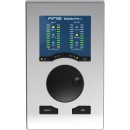
RME Babyface Pro FS |
VS | ||||
|---|---|---|---|---|---|
| Analog: 4 Input / 4 Output Digital: 12 Input / 12 Output |
Channels of I/O |
Analog: 2 Inputs / 4 Outputs at 192 kHz ADAT: 8 Inputs / 0 Outputs at 44.1/48 kHz 4 Inputs / 0 Outputs at 88.2/96 kHz 2 Inputs / 0 Outputs at 176.4/192 kHz S/PDIF: 2 Inputs / 0 Output at 44.1/48/88.2/96 kHz |
Analog: 4 Inputs / 8 Outputs at 96 kHz ADAT: 16 Inputs / 16 Outputs at 48 kHz S/PDIF: 2 Inputs / 2 Outputs |
10 Input / 14 Output |
Analog: 2 Inputs / 4 Outputs at 192 kHz |
| 192 kHz / 24-Bit | Maximum Sampling Rate | 192 kHz / 24-Bit | 96 kHz / 24-Bit | 96 kHz / 32-Bit | 192 kHz / 24-Bit |
| 2 Preamps | Number of Microphone Inputs | 2 | 4 Preamps | 2 Preamps | 2 Preamps |
| 2x XLR 3-Pin Balanced Mic/Line Input 2x 1/4" TS Unbalanced Line/Hi-Z Input 2x XLR 3-Pin Balanced Monitor Output 1x 1/4" TRS Unbalanced Headphone Output 1x 1/8" / 3.5 mm TRS Unbalanced Headphone Output |
Analog Audio I/O |
2x Combo XLR-1/4" TRS Balanced/Unbalanced Mic/Line Input 1x 1/4" TS Unbalanced Hi-Z Input (Front Panel) 2x 1/4" TRS Balanced/Unbalanced Monitor Output 2x 1/4" TRS Balanced/Unbalanced Line Output 1x 1/4" TRS Unbalanced Headphone Output |
4x Combo XLR-1/4" TRS Balanced Mic/Line Input 2x 1/4" TS Unbalanced Hi-Z Input 4x 1/4" TRS Balanced Line Output 2x 1/4" TRS Unbalanced Headphone Output 1x 1/8" / 3.5 mm TRS Unbalanced Headphone Output 2x 1/4" TRS Balanced Insert Send 2x 1/4" TRS Balanced Insert Return |
2x Combo XLR-1/4" 3-Pin Mic/Line Input 1x 1/4" TS Unbalanced Hi-Z Input (Front Panel) 2x 1/4" TRS Balanced Insert Send 2x 1/4" TRS Balanced Insert Return 4x 1/4" TRS Balanced Monitor Output 1x 1/4" TRS Headphone Output (Front Panel) 1x 1/8" / 3.5 mm TRS Headphone Output (Front Panel) |
2x Combo XLR-1/4" TRS Balanced/Unbalanced Mic/Line/Hi-Z Input 2x 1/4" TRS Balanced Monitor Output 4x RCA TS Unbalanced Line Output 2x 1/4" TRS Unbalanced Headphone Output |
| 1x TOSLINK Optical ADAT / S/PDIF Input 1x TOSLINK Optical ADAT / S/PDIF Output |
Digital Audio I/O | 1x TOSLINK Optical ADAT / S/PDIF Input (S/MUX4 Support) |
2x TOSLINK Optical ADAT / S/PDIF Input (S/MUX Support) 2x TOSLINK Optical ADAT / S/PDIF Output (S/MUX Support) |
1x TOSLINK Optical ADAT / S/PDIF Input 1x TOSLINK Optical ADAT / S/PDIF Output |
- |
| 1x USB-B | Host Connection | 1x USB-C | 1x USB-C | 1x USB-C | 1x USB-C |
| macOS Windows |
OS Compatibility | Windows 10 to 11 (64-Bit Only) |
macOS 10.11.6 or Later Windows 8 or Later (32-/64-Bit) |
Windows macOS |
macOS 10.11 macOS 10.12 macOS 10.13 macOS 10.14 macOS 10.15 Windows 8.1 Windows 10 |
| AC/DC Power Adapter (Not Included), USB Bus Power | Power Requirements | AC/DC Power Adapter (Included) | AC/DC Power Adapter (Included) | USB Bus Power | USB Bus Power |
